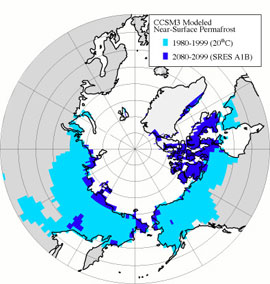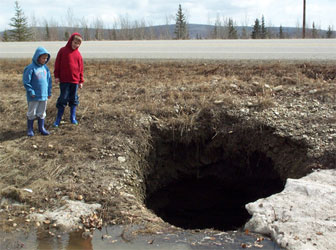Arctic permafrost could melt by 2100 worsening global warming
Rhett A. Butler, mongabay.com
December 19, 2005
Global warming could cause the top 10 feet (3 meters) or more of Arctic permafrost to thaw by 2100 according to new simulations from the National Center for Atmospheric Research (NCAR). Melting could disrupt important ecosystems, damage roads and buildings, increase freshwater runoff into the Acrtic Ocean and release large amounts of carbon into the atmosphere.
Scientists are concerned that the thawing of perennially frozen soil across the Northern Hemisphere could lead to large-scale emissions of methane or carbon dioxide at levels beyond those produced by the combustion of fossil fuels. Since permafrost may hold 30% or more of all the carbon stored in soils worldwide, greenhouse gas emissions from melting could dwarf proposed cuts under the Kyoto protocol.
A news release detailing the NCAR research follows.
Most of Arctic’s Near-Surface Permafrost May Thaw by 2100
NCAR release
December 19, 2005
Global warming may decimate the top 10 feet (3 meters) or more of perennially frozen soil across the Northern Hemisphere, altering ecosystems as well as damaging buildings and roads across Canada, Alaska, and Russia. New simulations from the National Center for Atmospheric Research (NCAR) show that over half of the area covered by this topmost layer of permafrost could thaw by 2050 and as much as 90 percent by 2100. Scientists expect the thawing to increase runoff to the Arctic Ocean and release vast amounts of carbon into the atmosphere.
The study, using the NCAR-based Community Climate System Model (CCSM), is the first to examine the state of permafrost in a global model that includes interactions among the atmosphere, ocean, land, and sea ice as well as a soil model that depicts freezing and thawing. Results appear online in the December 17 issue of Geophysical Research Letters.
“People have used models to study permafrost before, but not within a fully interactive climate system model,” says NCAR’s David Lawrence, the lead author. The coauthor is Andrew Slater of the University of Colorado’s National Snow and Ice Data Center.
 Near-surface permafrost Regions containing permafrost within the top 11 feet of soil could decrease by as much as 90% across the Arctic over the next century, based on simulations by the NCAR Community Climate System Model. Shown are areas with near-surface permafrost in the CCSM simulations for 1980-1999 (light blue) and 2080-2099 (dark blue). The latter projection is based on the Intergovernmental Panel on Climate Change’s A1B emissions scenario, often called the “business as usual” scenario. (Image courtesy David Lawrence.) |
About a quarter of the Northern Hemisphere’s land contains permafrost, defined as soil that remains below 32 degrees F (0 degrees C) for at least two years. Permafrost is typically characterized by an active surface layer, extending anywhere from a few centimeters to several meters deep, which thaws during the summer and refreezes during the winter. The deeper permafrost layer remains frozen. The active layer responds to changes in climate, expanding downward as surface air temperatures rise. Deeper permafrost has not thawed since the last ice age, over 10,000 years ago, and will be largely unaffected by global warming in the coming century, says Lawrence.
Recent warming has degraded large sections of permafrost across central Alaska, with pockets of soil collapsing as the ice within it melts. The results include buckled highways, destabilized houses, and “drunken forests”–trees that lean at wild angles. In Siberia, some industrial facilities have reported significant damage. Further loss of permafrost could threaten migration patterns of animals such as reindeer and caribou.
The CCSM simulations are based on high and low projections of greenhouse-gas emissions for the 21st century, as constructed by the Intergovernmental Panel on Climate Change. In both cases, the CCSM determined which land areas would retain permafrost at each of 10 soil depths extending down to 11.2 feet (3.43 meters).
For the high-emission scenario, the area with permafrost in any of these layers shrinks from 4 million to just over 1 million square miles by the year 2050 and decreases further to about 400,000 square miles (1 million square kilometers) by 2100. In the low-emission scenario, which assumes major advances in conservation and alternative energy, the permafrost area shrinks to about 1.5 million square miles by 2100.
 Sinkhole This sinkhole near Fairbanks, Alaska, formed due to the melting of a large ice pocket within permafrost that is gradually thawing as temperatures warm. (Photo courtesy Vladimir Romanovsky, Geophysical Institute, University of Alaska Fairbanks.) Related articles Warming could free far more carbon from high Arctic soil than earlier thought December 5, 2005 Massive climate change rocked ecosystems, animals 55 million years ago November 14, 2005 Summers in arctic getting longer and hotter September 23, 2005 Vegetation growth in Arctic could add to global warming September 8, 2005 Ocean gas hydrates could trigger catastrophic climate change September 6, 2005 |
“Thawing permafrost could send considerable amounts of water to the oceans,” says Slater, who notes that runoff to the Arctic has increased about 7 percent since the 1930s. In the high-emission simulation, runoff grows by another 28 percent by the year 2100. That increase includes contributions from enhanced rainfall and snowfall as well as the water from ice melting within soil.
The new study highlights concern about emissions of greenhouse gases from thawing soils. Permafrost may hold 30% or more of all the carbon stored in soils worldwide. As the permafrost thaws, it could lead to large-scale emissions of methane or carbon dioxide beyond those produced by fossil fuels.
“There’s a lot of carbon stored in the soil,” says Lawrence. “If the permafrost does thaw, as our model predicts, it could have a major influence on climate.” To address this and other questions, Lawrence and colleagues are now working to develop a more advanced model with interactive carbon.
This study was funded by the National Science Foundation, which is NCAR’S primary sponsor, and the U.S. Department of Energy. Opinions, findings, conclusions, or recommendations expressed in this publication do not necessarily reflect the views of NSF.
The National Snow and Ice Data Center (NSIDC) is part of the Cooperative Institute for Research in Environmental Sciences at the University of Colorado. For more information about NSIDC, please visit http://nsidc.org
This article includes a modified news release from NCAR.